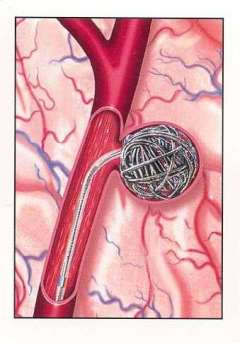Disease Associations
Intracranial Aneurysm
The most serious possible complication of PKD is a cerebral or brain aneurysm (a bulging blood vessel due to weakening of the blood vessel wall). Aneurysms can rupture, causing bleeding into the brain (subarachnoid hemorrhage). If not treated before the aneurysm ruptures, this can lead to irreversible brain damage or death. Aneurysm rupture occurs most often in people with larger aneurysms (>10 mm). The most common symptom of subarachnoid hemorrhage is a severe headache that begins suddenly, frequently with nausea and vomiting.
Approximately 3 to 7 percent of young adults with ADPKD may have brain aneurysms, and the frequency increases to 12 to 15 percent if someone else in the patient’s family has had an intracranial aneurysm. Compared with the general population, the risk of developing an aneurysm in ADPKD is approximately fivefold greater. People with a first-degree relative with a history of intracranial aneurysm or subarachnoid hemorrhage are at the highest risk of forming an aneurysm.
Early detection (before symptoms occur) of intracranial aneurysms is recommended in people who are at high risk. Screening (looking for an aneurysm before it ruptures) is generally performed with magnetic resonance angiography (MRA) or, if not available, a computed tomography (CT) scan.
Routine screening is recommended only for high-risk patients, such as those with a previous rupture, a positive family history of a brain hemorrhage or stroke, warning symptoms (eg, unusual headaches), in whom a loss of consciousness would place the patient or others at extreme risk.

PKD and the Liver
Polycystic liver disease (PLD) is a rare condition that causes cysts which are fluid-filled sacs to grow throughout the liver. A normal liver has a smooth, uniform appearance. A polycystic liver can look like a cluster of large grapes. Cysts can also grow independently in different parts of the liver. The cysts, if they get too numerous or large, may cause discomfort and health complications.
The majority of people with polycystic liver disease inherit the condition, but PLD can occur randomly with no genetic link. Women are affected more often than men and tend to have more cysts.
PLD is most common in people who have polycystic kidney disease (PKD), with its frequently increasing with age and advanced renal disease.
Most people don't discover they have PLD until they are adults, when the cysts become large enough to detect. Cysts can vary in size from no bigger than a pinhead to almost 4 inches wide. Likewise, your liver can stay its normal size or become extremely enlarged. No matter the number of size of cysts, polycystic livers continue to function normally and the disease is not considered life threatening.
Most of the time, people with polycystic liver disease have no symptoms. However, if the liver becomes enlarged and riddled with cysts, symptoms may include abdominal pain & bloating or swelling in the abdomen.
Only about one out of every 10 people with PLD has problems associated with it. In addition to severe abdominal pain, other complications may include:
- Bleeding into a cyst
- Infection of a cyst
- Yellowing of the skin and eyes due to resulting metabolic disorders
Because symptoms do not always occur, the majority of people learn they have PLD during a routine medical exam or diagnosis of kidney disease related to polycystic kidney disease.
Treatment is usually not needed unless you have symptoms. Mild pain associated with PLD can be treated with pain medication. However, if the cysts cause significant discomfort or other complications, there are a number of treatment options.
Cyst Aspiration: If a cyst is blocking a bile duct or if it has become infected, your doctor may recommend draining it. During cyst aspiration, your doctor, guided by ultrasound or CT imaging, will use a needle or catheter to drain the fluid in the cyst or cysts.
Cyst Fenestration: If you have large cysts on the surface of your liver, your doctor may suggest you have surgery to remove the wall of the cyst - a process called cyst fenestration.
Liver Resection: If the majority of cysts are in a particular area of the liver, your doctor may be able to surgically remove that part of the liver to provide pain relief and reduce the size of the liver.
Liver Transplantation: If liver resection is not possible or doesn't relieve your symptoms, a liver transplant may be an option. This treatment is typically reserved for people who are experiencing severe abdominal pain, having trouble eating, and whose overall quality of life is suffering.
Disclaimer: The UCLA Health System cannot guarantee the accuracy of such information. The information is provided without warranty or guarantee of any kind. Please speak to your Physician before making any changes.